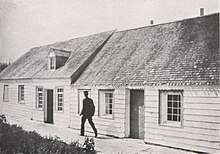Rigolet
Rigolet (Inuttitut: Tikigâksuagusik) (population 310) is a remote, coastal Labrador community established in 1735 by French-Canadian trader Louis Fornel. The town is the southernmost officially recognized Inuit community in the world.[2] Located on Hamilton Inlet, which is at the entrance to fresh water Lake Melville; Rigolet is on salt water and is accessible to navigation during the winter. Although there is no road access, the community is accessible by snowmobile trail, Rigolet Airport, or seasonally via a coastal ferry from Happy Valley-Goose Bay.

Rigolet Tikigâksuagusik[1] | |
|---|---|
Town | |
 Rigolet Location of Rigolet in Labrador  Rigolet Rigolet (Canada) | |
| Coordinates: 54°10′47″N 58°25′44″W | |
| Country | Canada |
| Province | Newfoundland and Labrador |
| Region | Nunatsiavut |
| Settled | 1735 |
| Incorporated | 1977 |
| Government | |
| • Mayor (AngajukKâk) | Jack Shiwak |
| • Federal MP | Yvonne Jones (L) |
| • Provincial MHA | Lela Evans (PC) |
| • Nunatsiavut Assembly members | Darryl Shiwak (I) |
| Population | |
| • Total | 310 |
| Time zone | UTC−04:00 (AST) |
| • Summer (DST) | UTC−03:00 (ADT) |
| Area code(s) | 709 |
Although there are still coniferous trees surrounding the village, a few kilometres northeast into Hamilton Inlet, the terrain changes drastically to a sub-arctic tundra. Minke and humpback whales are commonly observed in nearby waters. Rigolet is part of the Labrador Inuit Land Claims area and is overseen by the Nunatsiavut government. Approximately 5% of Rigolet's population is non Inuit.
In John Wyndham's post-apocalyptic novel The Chrysalids, set at an unspecified future date, Rigolet has become the town of Rigo and the capital of Labrador (which is one of the few habitable areas left in North America.)
See also
References
- https://www.erudit.org/en/journals/etudinuit/2005-v29-n1-2-etudinuit1430/013939ar/
- "Welcome to Rigolet". rigolet.ca. Retrieved 2019-04-17.